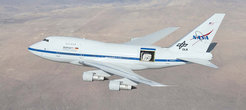SOFIA - the observatory above the clouds
Airborne observatory SOFIA provides astronomers with a new window into space
If you want to reach for the stars, you have to lift off. This could be the motto of SOFIA, a jumbo jet which has been converted into an observatory. On board it carries a 2.7-metre telescope, which the researchers use to observe the birthplaces of distant suns, galactic molecular clouds or the envelopes of planets in the infrared as they fly above Earth’s disturbing atmosphere at an altitude of 15 kilometres.
Text: Helmut Hornung

If you look up to the sky on a clear starlit night, you see only a single octave of the mighty keyboard which makes up the cosmos. This is because our eyes perceive only the visible light. And also because the Earth’s atmosphere blocks out a large part of the radiation from space such as gamma rays, X-rays or infrared light. It is in this spectral region that exploded suns, infant planetary systems or the cores of distant galaxies appear to be especially interesting. The astronomers therefore work with an armada of satellite telescopes above the terrestrial blanket of smog. And a short while ago they also opened an observation post directly above the clouds: SOFIA.
The name of the flying observatory stands for Stratospheric Observatory for Infrared Astronomy. SOFIA is a passenger on a converted Boeing 747SP jumbo jet and has a telescope with a mirror measuring 2.7 metres in diameter. This giant eye surveys the universe in the infrared spectral region from a height of 12 to 15 kilometres. At this altitude, above the troposphere, SOFIA leaves almost all the water vapour behind which otherwise swallows up the long wavelength light from space.
The telescope is mounted in the tail of the plane and hermetically sealed off from the cabin. Once the plane has reached its flying altitude, doors in the fuselage slide apart and the instrument observes in the open air, at low pressure and outside temperatures of around minus 60 degrees. The primary mirror with the above-mentioned 2.7-metre diameter weighs roughly 800 kg; it captures the radiation from space and projects it onto the smaller secondary mirror, which focuses it and sends it to a tertiary mirror, which finally guides it to the image plane of the scientific instrument to which it is connected.
The Forcast infrared camera developed at Cornell University in the US was the first of nine instruments of the “first light generation” to go into operation. At the beginning of April it was then the turn of GREAT, Germany’s contribution. This spectrometer surveys the universe in the far-infrared region at wavelengths between 60 and 250 micrometres, which are not accessible from the surface of the Earth because of the water vapour absorption in the atmosphere.
As SOFIA touched down on the runway of Dryden Aircraft Operations Facility in Palmdale, California at 6:40 a.m. local time on 6 April 2011 it heralded a new era for observing astronomy: “Even the first spectra show the outstanding scientific potential of airborne far-infrared spectroscopy,” says Rolf Güsten, the delighted head of the GREAT project and a scientist at the Max Planck Institute for Radio Astronomy in Bonn, Germany after the maiden flight. The telescope’s large collecting area coupled with enormous advances in Terahertz technologies in recent years allow GREAT to collect data 100 times faster than in earlier experiments. “This opens up the way for unique scientific observations.”
The programme back then consisted of the molecular cloud M 17, a region with enhanced star formation in our Milky Way, and also the IC 342 galaxy only few million light years away. In both sources GREAT not only registered the radiation of ionised carbon at a wavelength of 0.158 millimetres, but also spectral lines of warm carbon monoxide at high excitation. These lines are evidence of atomic processes which lead to a cooling of the interstellar matter.
